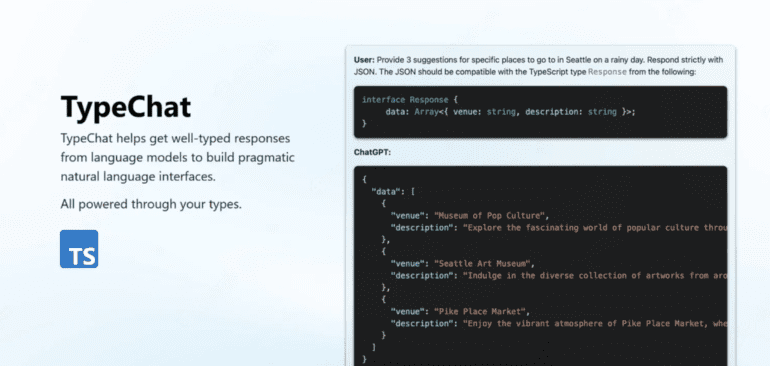TL;DR:
- Microsoft introduces TypeChat, a TypeScript-based open-source library for building natural language interfaces to large language models (LLMs) using types.
- TypeChat bridges the gap between natural language, application schema, and APIs, enabling type-safe AI responses.
- It simplifies the development of natural language interfaces, replacing prompt engineering with schema engineering.
- Developers define types representing intents in the application, and TypeChat constructs prompts for LLMs while ensuring schema conformance.
- TypeChat’s versatility addresses various questions raised by developers about integrating LLMs into existing app interfaces.
Main AI News:
In a bid to simplify the development of natural language interfaces for large language models (LLMs), Microsoft has unveiled its innovative TypeChat library. This open-source tool, available on GitHub, harnesses the power of TypeScript and generative AI to bridge the gap between natural language, application schema, and APIs. With TypeChat, developers can now access structured AI responses that are type-safe, by leveraging the type definitions within their applications.
The complexity of crafting natural language interfaces has been a longstanding challenge for app developers, often requiring intricate decision trees to decipher user intent and gather the necessary inputs for actions. TypeChat emerges as a game-changer, replacing conventional prompt engineering with a more efficient schema engineering approach.
How does TypeChat work? Developers can define various types that represent the supported intents in a natural language application. This can be as simple as categorizing sentiment or as elaborate as defining types for a shopping cart or music application. Once these types are established, TypeChat constructs a prompt to the LLM, utilizing the defined types and ensuring that the LLM’s response adheres to the schema. In cases where validation fails, TypeChat employs further language model interaction to rectify any non-conforming output. Additionally, the library summarizes the instance and verifies its alignment with user intent, ensuring a seamless experience.
TypeChat’s creators acknowledge the recent surge of excitement surrounding LLMs and the plethora of questions posed by developers. While chat assistants have been a direct and obvious application, integrating these models into existing app interfaces has raised inquiries about augmenting traditional UIs with natural language capabilities and utilizing AI to transform user requests into actionable app forms. TypeChat steps up to the challenge and aims to address these very questions.
With TypeChat, Microsoft envisions a future where building natural language interfaces for large language models becomes more accessible and convenient. By simplifying the development process and providing type-safe AI responses, TypeChat brings us one step closer to a world where interactions with technology feel increasingly human-like and effortless. Developers worldwide can now embrace this powerful library to enhance user experiences and unlock the full potential of natural language interfaces in their applications.
Conclusion:
Microsoft’s TypeChat library represents a significant advancement in the market of natural language interfaces for large language models. By streamlining the development process and providing type-safe AI responses, TypeChat offers developers an efficient solution to build more intuitive and user-friendly applications. This tool’s versatility not only caters to chat assistants but also opens up possibilities for integrating natural language capabilities into traditional UIs. As the demand for seamless interactions with technology continues to rise, TypeChat empowers developers to stay ahead of the curve and create innovative applications that meet users’ evolving needs.

